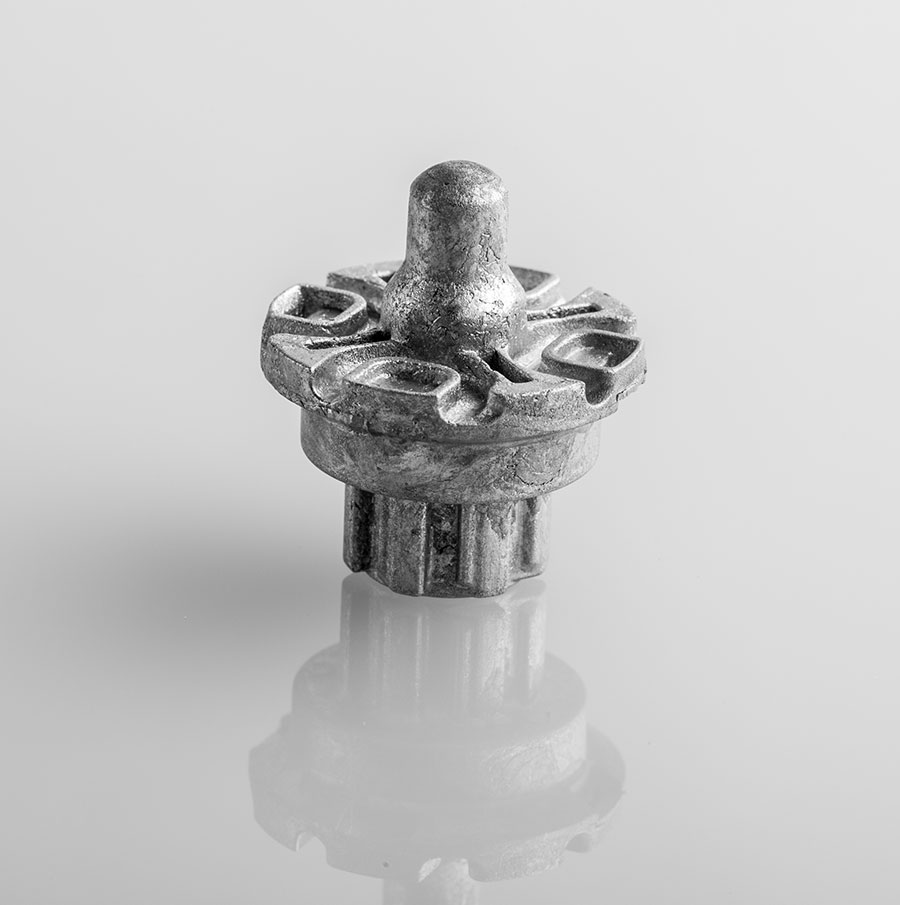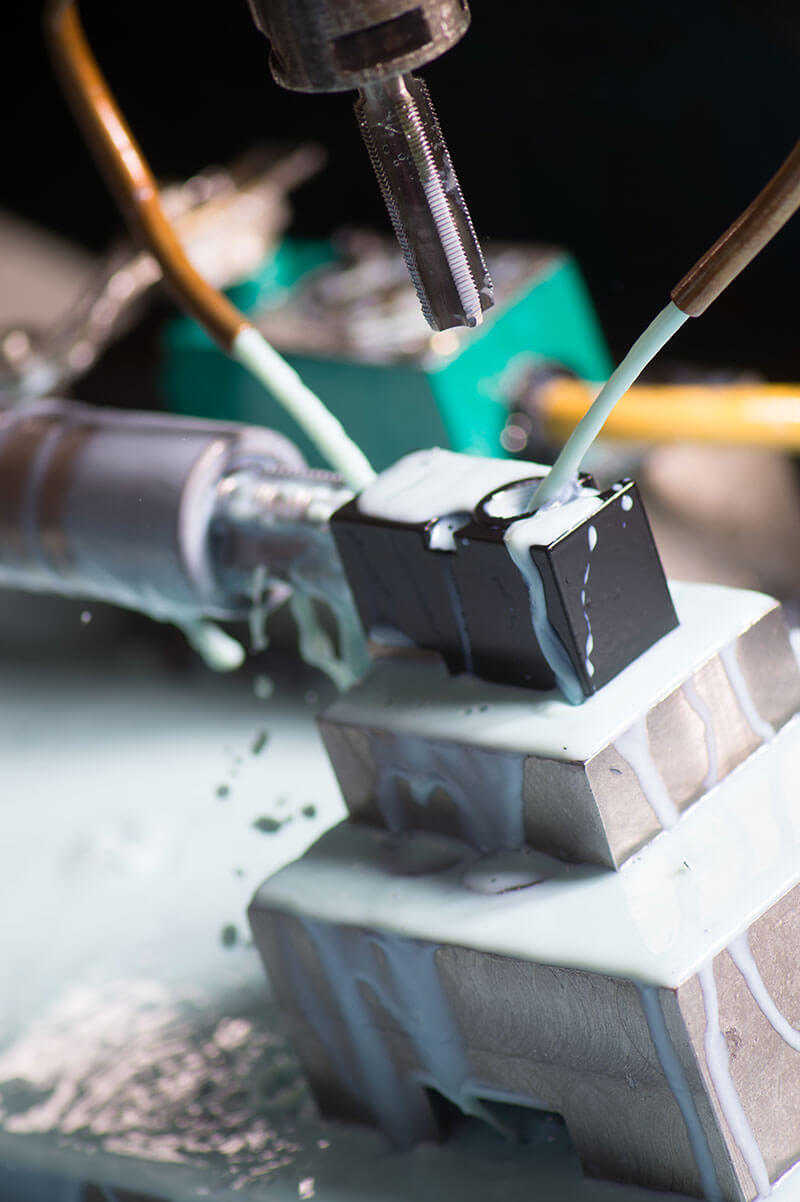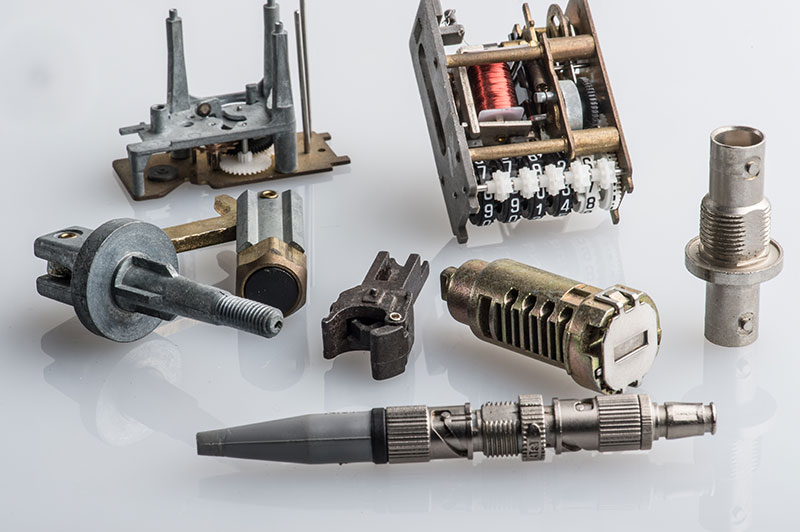Zinc is versatile and economical. It allows for thinner wall sections and smoother surfaces. In high-pressure, high-volume casting, it has the advantage of longer-lasting molds and can be processed with tighter tolerances and less machining.
Zinc alloy generally allows for greater variation in section design and for the maintenance of closer dimensional tolerances. Zinc alloy die castings offer a broad range of excellent physical and mechanical properties, cast ability and finishing characteristics. The impact strength of zinc components is higher then other die casting alloys with the exception of brass.
PDC uses certified raw material that is locally sourced—for truly made in the USA.

Alloys Z5 and Z3 are by far the most commonly used. Most diecasting companies are set up to use one of these alloys as standard.
Using another alloy is possible but imposes extra metal melting and scrap handling costs. Therefore, to achieve the minimum price for any casting design, Z3 or Z5 should be specified whenever possible.
Strength and Stability
Z5 is stronger than Z3, but if a standard safety factor has been applied when designing the casting, a ZP3 casting would probably be perfectly satisfactory in service.
Z3 has better dimensional stability than Z5, but it is only where dimensional tolerances are extremely critical that this would need to be considered. Therefore Z3 and Z5 are interchangeable for most applications. The creep resistance of Z5 is superior to that of Z3, so it is more suitable for use at elevated temperatures under continual stress.
Z2 (known as kirksite) and ZA8 are considered to be special-purpose or heavy-duty alloys. Their strength and hardness are superior to those of Z3 and Z5.
When to use Z2 or ZA8
Which of these alloys to choose when their extra strength, hardness, and wear resistance are required depends on what other critical attributes are required of the casting. The dimensional stability of ZA8 is excellent. Z2 is not as good as the other alloys, although still good enough for the majority of castings. The aging characteristics of Z2 are its chief drawback because the impact strength and ductility fall over time at elevated temperatures (~212°F). For many applications, however, these are not significant factors.
Porosity and Creep Resistance
ZA8 is capable of producing sound castings when sections are reasonably even. However, when isolated heavier sections are included in the design, these are likely to display more and larger porosity. ZA8 is also more expensive to cast because it is harder on the components of the diecasting machine shot system and dies, which need more frequent replacement.
The creep resistance of Z2 and ZA8 are approximately equal and superior to those of Z3 and Z5. However, the creep data for ZA8 has been more adequately characterized than for Z2, and more confidence can be placed in the results of creep predictions for ZA8.
All alloys can undergo post-casting forming operations, and are especially ductile immediately after the casting operation. When there is a delay between casting and the forming process, Z7 will be found to be the most readily formed alloy.


All alloys machine well. Z3 and Z7, being softer, tend to pick up on cutting tools, which can lead to burrs and a poor finish. This problem can be avoided by adequate flood cooling.
In summary, the wear resistance of diecasting zinc alloys is generally in line with their hardness. Z2 and ZA8 are the best, followed by Z5, Z3, then Z7.
Check out the charts below for a deeper look into zinc alloys.
| Alloy | #2 | #3 | #5 | #7 | ZA-8 | AcuZinc |
| Mechanical Properties | Die Cast | Die Cast | Die Cast | Die Cast | Die Cast | Die Cast |
| Ultimate Tensile Strength: Psi (MPa) | 52,000 (359) | 41,000 (283) | 47,600 (328) | 41,000 (283) | 54,200 (374) | 59,000 (407) |
| Yield Strength: (0.2% Offset) psi (MPa) | 41,000 | 32,000 (221) | 33,000 (228) | 32,000 (221) | 42,000 (290) | 49,000 (338) |
| Elongation: % in 2” (51mm) | 7 | 10 | 7 | 13 | 6-10 | 5 |
| Shear Strength Psi (Mpa) Hardness: Brinell | 46,000 (317) 100 | 31,000 (214) up to 82 | 38,000 (262) up to 91 | 31,000 (214) 80 | 40,000 (275) up to 110 | 40,600 (280) 118 |
| Impact Strength: ft-lb (J) ¼” square specimen | 35 (47.5) | 43 (58) | 48 (65) | 43 (58) | 24-35 (32-48) | |
| Fatigue Strength Rotary Bend: 5×108 cycles psi x 10³ (MPa) | 8.5 (58.6) | 6.9 (47.6) | 8.2 (56.5) | 6.9 (47.6) | 15 (103) | |
| Compressive Yield Strength: 0.1% offset psi x 10³ (MPa) | 93 (641) | 60 (414) | 87 (600) | 60 (414) | 37 (252) | |
| Modulus of Elasticity: varies with stress level; applicable only for short-duration loads: psi x 106 (MPa x 10³) | 12.4 (85.5) | 12.4 (85.5) | 12.4 (85.5) | 12.4 (85.5) | 12.4 (85.5) |
| Physical Properties | #2 | #3 | #5 | #7 | ZA-8 | AcuZinc |
| Density: lb/cu in (g/cu cm) | .24 (6.6) | .24 (6.6) | .24 (6.6) | .24 (6.6) | .227 (6.3) | .247 (6.85) |
| Melting Range: F° (C°) | 715-734 (379-390) | 718-728 (381-387) | 717-727 (380-386) | 718-728 (381-387) | 707-759 (375-404) | 755-936 (402-502) |
| Electrical Conductivity: % IACS | 25 | 27 | 26 | 27 | 27.7 | 26.9 |
| Thermal Conductivity: BTU/ft/hr/F° (W/m/hr/C°) | 60.5 (104.7) | 65.3 (113) | 62.9 (109) | 65.3 (113) | 66.3 (115) | 61.2 (106) |
| Coefficient of Thermal Expansion: 68-212 F° µin/in/F° (100-200 C° µm/mm/C°) | 15.4 (27.8) | 15.2 (27.4) | 15.2 (27.4) | 15.2 (27.4) | 12.9 (23.2) | 13.3 (24) |
| Specific Heat: BTU/lb/F° (J/kg/C°) | .10 (419) | .10 (419) | .10 (419) | .10 (419) | .104 (435) | |
| Shrinkage: in/in | .006 | .006 | .006 | .006 | .007 | .006 |
| Chemical Specifications | #2 | #3 | #5 | #7 | ZA-8 | AcuZinc |
| Al (Aluminum) | 3.5-4.3 | 3.5-4.3 | 3.5-4.3 | 3.5-4.3 | 8.0-8.8 | 2.8-3.3 |
| Mg (magnesium) | .02-.05 | .02-.05 | .03-.008 | .005-.020 | .015-.030 | .025-.05 |
| Cu (Copper) | 2.5-3.0 | .25 max | .75-1.25 | .25 max | .8-1.3 | 5.0-6.0 |
| Fe (Iron) Max. | .10 | .10 | .10 | .075 | .075 | .075 |
| Pb (Lead) Max. | .005 | .005 | .005 | .003 | .006 | .005 |
| Cd (Cadmium) Max. | .004 | .004 | .004 | .002 | .006 | .004 |
| Sn (Tin) Max. | .003 | .003 | .003 | .003 | .003 | .003 |
| Ni (Nickel) Max. | .035 | .02 | .02 | .06 | .01 | .02 |